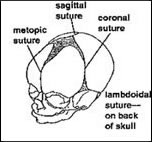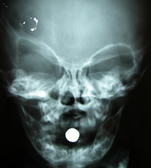What is Craniosynostosis?
 Craniosynostosis, or premature closure of the cranial sutures, occurs when the bones in a baby's skull fuse together before the brain has stopped growing. This can happen before the baby is born or in the first few months of life. When these growth plates fuse together prematurely, deformity can occur due to restricting expansion of the skull. When the growth is restricted in a certain direction, the brain will push outward in an alternative direction of least resistance and result in skull deformity. This results in a misshapen skull and face. The characteristic patterns of deformity caused by craniosynostosis are readily recognized by the trained eye, even without imaging studies. Nevertheless, a three dimensional CAT scan is often performed.
Craniosynostosis, or premature closure of the cranial sutures, occurs when the bones in a baby's skull fuse together before the brain has stopped growing. This can happen before the baby is born or in the first few months of life. When these growth plates fuse together prematurely, deformity can occur due to restricting expansion of the skull. When the growth is restricted in a certain direction, the brain will push outward in an alternative direction of least resistance and result in skull deformity. This results in a misshapen skull and face. The characteristic patterns of deformity caused by craniosynostosis are readily recognized by the trained eye, even without imaging studies. Nevertheless, a three dimensional CAT scan is often performed.
Causes of Craniosynostosis
This condition has several possible causes, including:

- Prenatal restraint of head growth, caused by early engagement of the baby's head into the mother's pelvis, or by sharing the uterus with a twin sibling
- Genetic syndrome disorder, such as Crouzon or Apert Syndrome
- Fetal exposure to toxins such as phenytoin, valproic acid, or other teratogens (extremely rare occurrence).
Craniosynostosis can also occur sporadically, with no known cause or related condition. These cases typically involve a single fusion, whereas cases related to syndromes will be more complex, involving the fusion of several sutures, as well as other conditions. In the case of either sporadic or syndromic occurrences, there are no known causes or risk factors.
Treatment for Craniosynostosis

Specific treatment for craniosynostosis will be determined by child's physician based on:
- Your child's age and overall health
- Type of craniosynostosis (which sutures are involved)
- Your child's tolerance for specific medications, procedures, or therapies
- Expectations for the course of the craniosynostosis
- Your opinion or preference
Surgery is typically the recommended treatment. The goal of treatment is to decrease the risk of developing increased pressure on the brain and correct deformities of the face and skull bones. Without surgical intervention, the skull deformities caused by craniosynostosis persist through life, and the risk of elevated pressure on the brain can cause significant disability.
 What to Expect
What to Expect
Find out what to expect during your child's hospital stay and treatment for craniosynostosis.